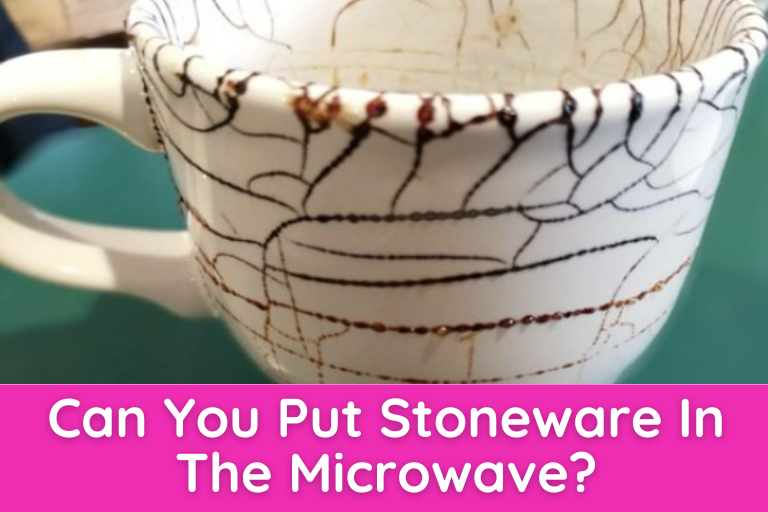Have you ever wanted to heat your food quickly without turning on the stove? Did you know that most stoneware is microwaveable and easy to use? From casseroles to leftovers, it’s a convenient way to get a hot meal in minutes.
Learn more about what stoneware can do for your cooking needs and how easy it is to put it in the microwave.
Can You Put Stoneware in the Microwave?
Yes, you can put the stoneware in the microwave! Stoneware is a type of clay-based ceramic material that’s generally safe to use in the microwave. Just make sure it’s labeled as microwave-safe and heat it according to any instructions that come with it. When microwaving, keep an eye on what you’re doing, and don’t leave for too long – stoneware can get extremely hot!
What happens if you microwave stoneware?
When you microwave stoneware, the microwaves penetrate the material and cause a reaction that produces heat. That heat is then used for cooking your food quickly and efficiently.
Not all stoneware is safe for microwaving, so look for pieces with a “microwave-safe” label before using them in the microwave. Additionally, be sure to follow the manufacturer’s instructions for safety and use.
How can you tell if stoneware is microwave safe?
If a stoneware item has a “microwave-safe” label, then you can be sure that it is safe to use in the microwave. Additionally, you can look for scratch-resistant surfaces and glazes specifically designed for microwaves. Some stoneware pieces may not be labeled as microwave-safe, but if they feature these design elements, it’s usually safe to assume they are.
Why did my stoneware crack in the microwave?
Your stoneware may have cracked in the microwave because it could not withstand high temperatures. Microwaves heat food quickly, so items not designed for use in microwaves can experience thermal shock and crack. Also, if a piece of stoneware is placed directly on the floor of the microwave, it can be subjected to intense levels of concentrated heat, which can also cause it to crack.
Does stoneware heat up in the microwave?
Yes, stoneware can heat up in the microwave. However, not all types of stoneware are designed to withstand high temperatures, so it’s important to check the label before using it in the microwave.
If a piece of stoneware does not feature a “microwave safe” label or design elements that indicate it is prepared for use in microwaves, then it should not be used in a microwave as doing so could cause it to crack.
Does all stoneware contain lead?
No, not all stoneware contains lead. Many types of stoneware are made from clay that contains no lead or other hazardous materials. However, it is important to check the label before use and ensure that it states “lead-free” or “dishwasher safe.”
If a piece of stoneware does not feature this type of label, then it likely contains some lead and should be avoided for food use.
What temperature is safe for stoneware?
The safe temperature for stoneware depends on the type and composition of the material.
Generally speaking, most types of stoneware can withstand temperatures up to 500°F (260°C) without damage, while some may be able to withstand even higher temperatures.
It is important to check the label before use to determine a piece of stoneware’s heat tolerance.
Will stoneware crack?
Yes, stoneware can crack under certain conditions. Stoneware is a clay-based material and thus is prone to cracking if exposed to extreme temperatures or sudden temperature changes. It can also be cracked by dropping it or hitting it against another hard object.
To avoid cracking, it’s important to handle stoneware carefully and use it within the specified temperature range on the label.
Is stoneware the same as ceramic?
No, stoneware and Ceramic are different materials. Stoneware is a type of clay-based material fired at a high temperature, making it durable and strong. On the other hand, Ceramic is a broader term for products made from clay that have been fired in a kiln to give them a hard, nonporous surface. The most common type of ceramics is earthenware and porcelain.
How do you heat stoneware?
Stoneware is typically heated in an oven or kiln to temperatures ranging from 1200F (650C) to 2200F (1200C). The type of heat used for stoneware depends on its purpose. For example, if it will be used for cooking, you should limit firing temperatures to 1800F (980C).
For decorative pieces, higher temperatures may be needed. Stoneware should always have a slow cooling process after firing, which can help prevent cracking.
Can ceramic be put in the microwave?
Yes, ceramic can be put in the microwave. However, it is important to pay attention to the type of Ceramic you are using, as some may contain metallic decorations which could spark when exposed to microwaves.
What are the disadvantages of stoneware?
Stoneware has a few disadvantages:
- It is typically quite heavy, making it difficult to transport or move.
- Stoneware can be more expensive than other types of ceramics because of the higher firing temperature used in its creation.
- Stoneware is less durable and may need to be glazed or coated with a protective layer if exposed to wear and tear.
Are stoneware dishes toxic?
No, stoneware dishes are not toxic and safe for food use. However, the glaze on some stoneware may contain lead or other impurities, so it is important to check the manufacturer’s instructions before using a piece of stoneware.
How can you tell if stoneware is food safe?
You can determine if stoneware is food safe by checking the manufacturer’s instructions. Generally, glazed stoneware dishes are safe for use with food as long as there are no signs of chipping or cracking.
Non-glazed pieces of stoneware should be properly fired before use to remove any potentially harmful materials. Additionally, it can be helpful to read consumer reviews to get an idea of the quality and safety of a particular piece of stoneware.
What are the advantages of stoneware?
One of the main advantages of stoneware is its durability and strength. Stoneware dishes are known to be quite hard and sturdy, making them less likely to chip, crack or break compared to other types of dinnerware.
They can also help keep temperatures consistent, making them great for serving hot and cold foods. Stoneware dishes are also often dishwasher-safe and require little maintenance.
Finally, stoneware comes in various colors and styles, making it a great option for adding a bit of style to your dinner table.
What causes stoneware to crack?
Stoneware can crack due to stress from thermal shock. Thermal shock occurs when stoneware is exposed to drastic temperature changes, causing the material to expand and contract rapidly.
This sudden expansion and contraction weakens the stoneware’s structure and can cause cracking or breaking if the piece is not thick enough. Also, dropping a piece of stoneware on a hard surface can cause it to crack.
Is stoneware healthy to use?
Yes, stoneware is generally considered healthy to use. Stoneware dishes are non-toxic and usually don’t contain any harmful chemicals, unlike plastic and other materials.
Additionally, the material is naturally porous, which allows it to absorb flavors without leaving a residue in the finished product. This makes stoneware perfect for cooking certain dishes like cornbread or soups.
How do I clean stoneware?
Cleaning stoneware is relatively simple:
- Soak the item in warm water and baking soda for 20 minutes to help remove any stubborn food stains.
- Rinse it off with warm water and a soft cloth.
- Dry the piece thoroughly with a clean cloth to prevent water spots from forming.
Be sure to avoid using soap or abrasive cleaners, as these can damage the finish of your stoneware dishes.
Conclusion
Stoneware can be a great choice for dinnerware and cookware due to its durability, strength, and ability to keep temperatures consistent. However, it is important to check the manufacturer’s instructions before using stoneware with food, as some glazed pieces may contain lead or other impurities.
Additionally, if you choose non-glazed pieces of stoneware, they should be fired appropriately to ensure that any potentially harmful materials have been removed. Now that we’ve gone through all this information about whether you can put the stoneware in the microwave, we’d love to hear from our readers!
What do you think? Have you ever used stoneware dishes? How did it work out for your needs? Let us know in the comments below!




